Development of a 1 kW Micro-Polygeneration System Fueled by Natural Gas for Single-Family Users
Abstract
:1. Introduction
2. Experimental Investigation
2.1. Engine Specifications
2.2. Fuel Properties
2.3. Testing Conditions
3. Experimental Results
3.1. Exhaust Emissions
4. Optimized Configuration Potential of Two Stroke Engines
5. Conclusions
Author Contributions
Funding
Institutional Review Board Statement
Informed Consent Statement
Data Availability Statement
Conflicts of Interest
Abbreviations
| 1D | One Dimensional |
| 3D | Three Dimensional |
| BBDC | Before Bottom Dead Center |
| BSFC | Brake Specific Fuel Consumption |
| B(F)TDC | Before (Firing) Top Dead Center |
| CAD | Crank Angle Degree |
| CFD | Computational Fluid Dynamics |
| CLA | Chemi-Luminescence Analyzer |
| CNG | Compressed Natural Gas |
| CR | Compression Ratio |
| DAQ | Data Acquisition |
| DAS | Data Acquisition System |
| DC | Direct Current |
| DI | Direct injection |
| DIS | Direct Injection System |
| DII | Department of Industrial Engineering of the University of Naples Federico II |
| EU | European Union |
| FID | Flame Ionization Detector |
| HC | Hydrocarbons |
| IMEP | Indicated Mean Effective Pressure |
| LHV | Lower Heating Value |
| NDIR | Non-Dispersive Infra-Red Detector |
| NG | Natural Gas |
| NMHC | Non Methanic Hydrocarbons |
| RC | Compression Ratio |
| R&D | Research and Development |
| RICE | Reciprocating Internal Combustion Engine |
| RON | Research Octane Number |
| SA | Spark Advance |
| SA0 | Reference Spark Advance |
| SI | Spark Ignition |
| THC | Total Hydrocarbons |
| UHC | Unburned Hydrocarbons |
| VOC | Volatile Organic Compounds |
| WOT | Wide Open Throttle |
Glossary
| Latin | Greek | ||
| Pb | Brake Power | αst | Stoichiometric Air-Fuel Ratio |
| Hi | Lower Heating Value | λ | Air-fuel equivalence ratio |
| Ki | Specific Thermal Content | ω | Angular Velocity |
| LS | Laminar Flame Speed | τ | Brake Torque |
| ṁa | Air Mass Flow Rate | ||
| ṁf | Fuel Mass Flow Rate | ||
| N | Rotational Speed | ||
| N0 | Reference engine speed | ||
| rpm | Revolutions Per Minute | ||
References
- Intergovernmental Panel on Climate Change. Global Warming of 1.5 °C. Available online: http://www.ipcc.ch (accessed on 20 July 2021).
- Directive 2012/27/EU of the European Parliament and of the Council on Energy Efficiency, Amending Directives 2009/125/EC and 2010/30/EU and Repealing Directives 2004/8/EC and 2006/32/EC. Available online: https://eur-lex.europa.eu/legal-content/EN/TXT/?uri=CELEX:32012L0027 (accessed on 20 July 2021).
- Pfeifer, A.; Dobravec, V.; Pavlinek, L.; Krajačić, G.; Duić, N. Integration of renewable energy and demand response technologies in interconnected energy systems. Energy 2018, 161, 447–455. [Google Scholar] [CrossRef]
- Gimelli, A.; Muccillo, M. The Key Role of the Vector Optimization Algorithm and Robust Design Approach for the Design of Polygeneration Systems. Energies 2018, 11, 821. [Google Scholar] [CrossRef] [Green Version]
- Calise, F.; Figaj, R.D.; Massarotti, N.; Mauro, A.; Vanoli, L. Polygeneration system based on PEMFC, CPVT and electrolyzer: Dynamic simulation and energetic and economic analysis. Appl. Energy 2017, 192, 530–542. [Google Scholar] [CrossRef]
- El-Emam, R.S.; Dincer, I. Assessment and Evolutionary Based Multi-Objective Optimization of a Novel Renewable-Based Polygeneration Energy System. ASME J. Energy Resour. Technol. 2016, 139. [Google Scholar] [CrossRef]
- Calise, F.; Cappiello, F.L.; Dentice d’Accadia, M.; Libertini, L.; Vicidomini, M. Dynamic Simulation and Thermoeconomic Analysis of a Trigeneration System in a Hospital Application. Energies 2020, 13, 3558. [Google Scholar] [CrossRef]
- D’Accadia, M.D.; Sasso, M.; Sibilio, S.; Vanoli, L. Micro-combined heat and power in residential and light commercial applications. Appl. Therm. Eng. 2003, 23, 1247–1259. [Google Scholar] [CrossRef]
- Valenti, G.; Bischi, A.; Campanari, S.; Silva, P.; Ravidà, A.; Macchi, E. Experimental and Numerical Study of a Microcogeneration Stirling Unit under On–Off Cycling Operation. Energies 2021, 14, 801. [Google Scholar] [CrossRef]
- Katsaros, G.; Nguyen, T.-V.; Rokni, M. Tri-generation System based on Municipal Waste Gasification, Fuel Cell and an Absorption Chiller. J. Sustain. Dev. Energy Water Environ. Syst. 2018, 6, 13–32. [Google Scholar] [CrossRef]
- Xie, D.; Lu, Y.; Sun, J.; Gu, C.; Yu, J. Optimal Operation of Network-Connected Combined Heat and Powers for Customer Profit Maximization. Energies 2016, 9, 442. [Google Scholar] [CrossRef] [Green Version]
- Markovska, N.; Duic, N.; Vad Mathiesen, B.; Guzovic, Z.; Piacentino, A.; Schlor, H.; Lund, H. Addressing the main challenges of energy security in the twenty-first century—Contributions of the conferences on Sustainable Development of Energy, Water and Environment Systems. Energy 2016, 115, 1504–1512. [Google Scholar] [CrossRef]
- Gimelli, A.; Mottola, F.; Muccillo, M.; Proto, D.; Amoresano, A.; Andreotti, A.; Langella, G. Optimal configuration of modular cogeneration plants integrated by a battery energy storage system providing peak shaving service. Appl. Energy 2019, 242, 974–993. [Google Scholar] [CrossRef]
- Calise, F.; di Vastogirardi, G.D.N.; d’Accadia, M.D.; Vicidomini, M. Simulation of polygeneration systems. Energy 2018, 163, 290–337. [Google Scholar] [CrossRef]
- Ren, H.; Zhou, W.; Nakagami, K.I.; Gao, W.; Wu, Q. Multi-objective optimization for the operation of distributed energy systems considering economic and environmental aspects. Appl. Energy 2010, 87, 3642–3651. [Google Scholar] [CrossRef]
- Gimelli, A.; Muccillo, M.; Sannino, R. Optimal design of modular cogeneration plants for hospital facilities and robustness evaluation of the results. Energy Convers. Manag. 2017, 134, 20–31. [Google Scholar] [CrossRef]
- Gimelli, A.; Luongo, A.; Muccillo, M. Efficiency and cost optimization of a regenerative Organic Rankine Cycle power plant through the multi-objective approach. Appl. Therm. Eng. 2017, 114, 601–610. [Google Scholar] [CrossRef]
- Carvalho, M.; Lozano, M.A.; Serra, L.M. Multicriteria synthesis of trigeneration systems considering economic and environmental aspects. Appl. Energy 2012, 91, 245–254. [Google Scholar] [CrossRef]
- Eppinger, B.; Muradi, M.; Scharrer, D.; Zigan, L.; Bazan, P.; German, R.; Will, S. Simulation of the Part Load Behavior of Combined Heat Pump-Organic Rankine Cycle Systems. Energies 2021, 14, 3870. [Google Scholar] [CrossRef]
- Wang, J.; Liu, W.; Liu, G.; Sun, W.; Li, G.; Qiu, B. Theoretical Design and Analysis of the Waste Heat Recovery System of Turbine Exhaust Steam Using an Absorption Heat Pump for Heating Supply. Energies 2020, 13, 6256. [Google Scholar] [CrossRef]
- Muccillo, M.; Gimelli, A. Experimental Development, 1D CFD Simulation and Energetic Analysis of a 15 kW Micro-CHP Unit based on Reciprocating Internal Combustion Engine. Appl. Therm. Eng. 2014, 71, 760–770. [Google Scholar] [CrossRef]
- Cirillo, N.C.; Cozzolino, R. Micro-cogeneration with LPG fuelled S.I. engines: New ways for emissions control. In Proceedings of the 1998 Fall Technical Conference of the ASME Internal Combustion Engine Division, Part 1 (of 3), Clymer, NY, USA, 27–30 September 1998; pp. 63–69. [Google Scholar]
- Kojima, M.; Brandon, C.; Shah, J. Improving Urban Air Quality in South Asia by Reducing Emissions from Two-Stroke Engine Vehicles; The International Bank for Reconstruction and Development/The World Bank: Washington, DC, USA, 2000. [Google Scholar]
- Muslim, M.T.; Selamat, H.; Alimin, A.J.; Rohi, N.M.; Hushim, M.F. A retrofit fuel injection technology for small carburetted motorcycle engines towards lower fuel consumption and clearer exhaust emissions. Renew. Sustain. Energy Rev. 2014, 35, 279–284. [Google Scholar] [CrossRef] [Green Version]
- Gimelli, A.; Cascone, C.; Pennacchia, O.; Unich, A.; Capaldi, P. Performance and Emissions of a Natural Gas Fueled Two-Stroke SI Engine; SAE Paper Number 2008-01-0318, SAE 2008 World Congress & Exhibition; SAE: Warrendale, PA, USA, 2008. [Google Scholar] [CrossRef]
- De Nola, F.; Giardiello, G.; Gimelli, A.; Molteni, A.; Muccillo, M.; Picariello, R. A Model-Based Computer Aided Calibration Methodology Enhancing Accuracy, Time and Experimental Effort Savings through Regression Techniques and Neural Networks; SAE Technical Paper # 2017-24-0054; SAE: Warrendale, PA, USA. [CrossRef] [Green Version]
- De Nola, F.; Giardiello, G.; Gimelli, A.; Molteni, A.; Muccillo, M.; Picariello, R. Volumetric efficiency estimation based on neural networks to reduce the experimental effort in engine base calibration. Fuel 2019, 244, 31–39. [Google Scholar] [CrossRef]
- Forster, P.; Ramaswamy, V.; Artaxo, P.; Berntsen, T.; Betts, R.; Fahey, D.W.; Haywood, J.; Lean, J.; Lowe, D.C.; Myhre, G.; et al. Changes in Atmospheric Constituents and in Radiative Forcing. In Climate Change 2007: The Physical Science Basis; Solomon, S., Qin, M.D., Manning, Z., Chen, M., Marquis, K.B., Averyt, M.T., Miller, H.L., Eds.; Contribution of Working Group I to the Fourth Assessment Report of the Intergovernmental Panel on Climate Change; Cambridge University Press: Cambridge, UK; New York, NY, USA, 2017. [Google Scholar]
- Bozza, F.; Gimelli, A. A Comprehensive 1D Model for the Simulation of a Small-Size Two-Stroke SI Engine. SAE Trans. 2004, 758–770. [Google Scholar] [CrossRef]
- Gimelli, A.; Muccillo, M.; Pennacchia, O. Study of a New Mechanical VVA System. Part I: Valve Train Design and Friction Modeling. Int. J. Engine Res. 2015, 16, 750–761. [Google Scholar] [CrossRef]
- Gimelli, A.; Muccillo, M.; Pennacchia, O. Study of a New Mechanical VVA System. Part II: Estimation of the Actual Fuel Consumption Improvement through 1D Fluid Dynamic Analysis and Valve Train Friction Estimation. Int. J. Engine Res. 2015, 16, 762–772. [Google Scholar] [CrossRef]
- Bozza, F.; Fontanesi, S.; Gimelli, A.; Severi, E.; Siano, D. Numerical and Experimental Investigation of Fuel Effects on Knock Occurrence and Combustion Noise in a 2-Stroke Engine. SAE Int. J. Fuels Lubr. 2012, 5, 674–695. [Google Scholar] [CrossRef]
- Fontanesi, S.; Severi, E.; Bozza, F.; Gimelli, A. Investigation of Scavenging, Combustion and Knock in a Two-Stroke SI Engine Operated with Gasoline and CNG. Int. J. Automot. Eng. 2012, 3, 97–105. [Google Scholar] [CrossRef] [Green Version]


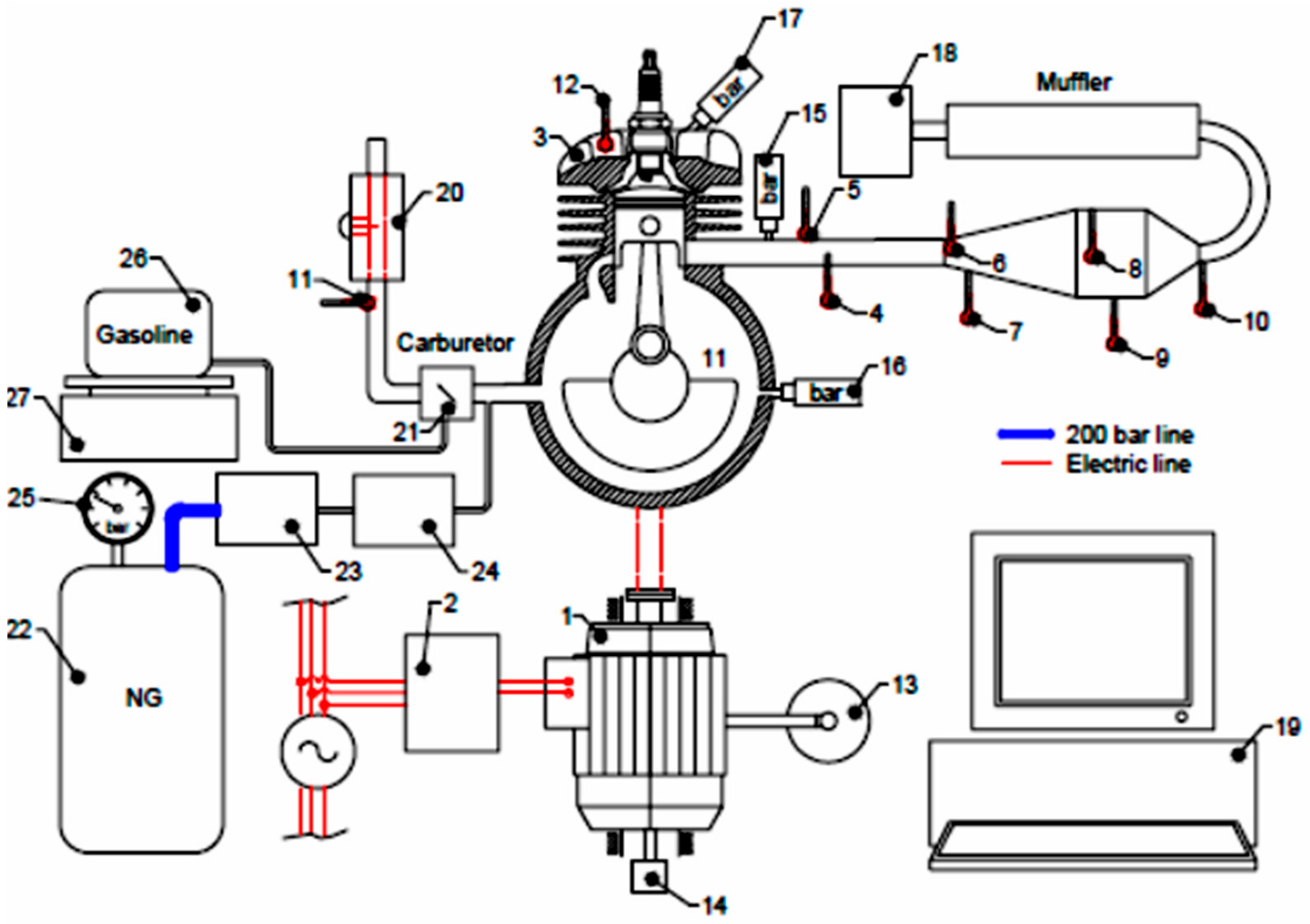

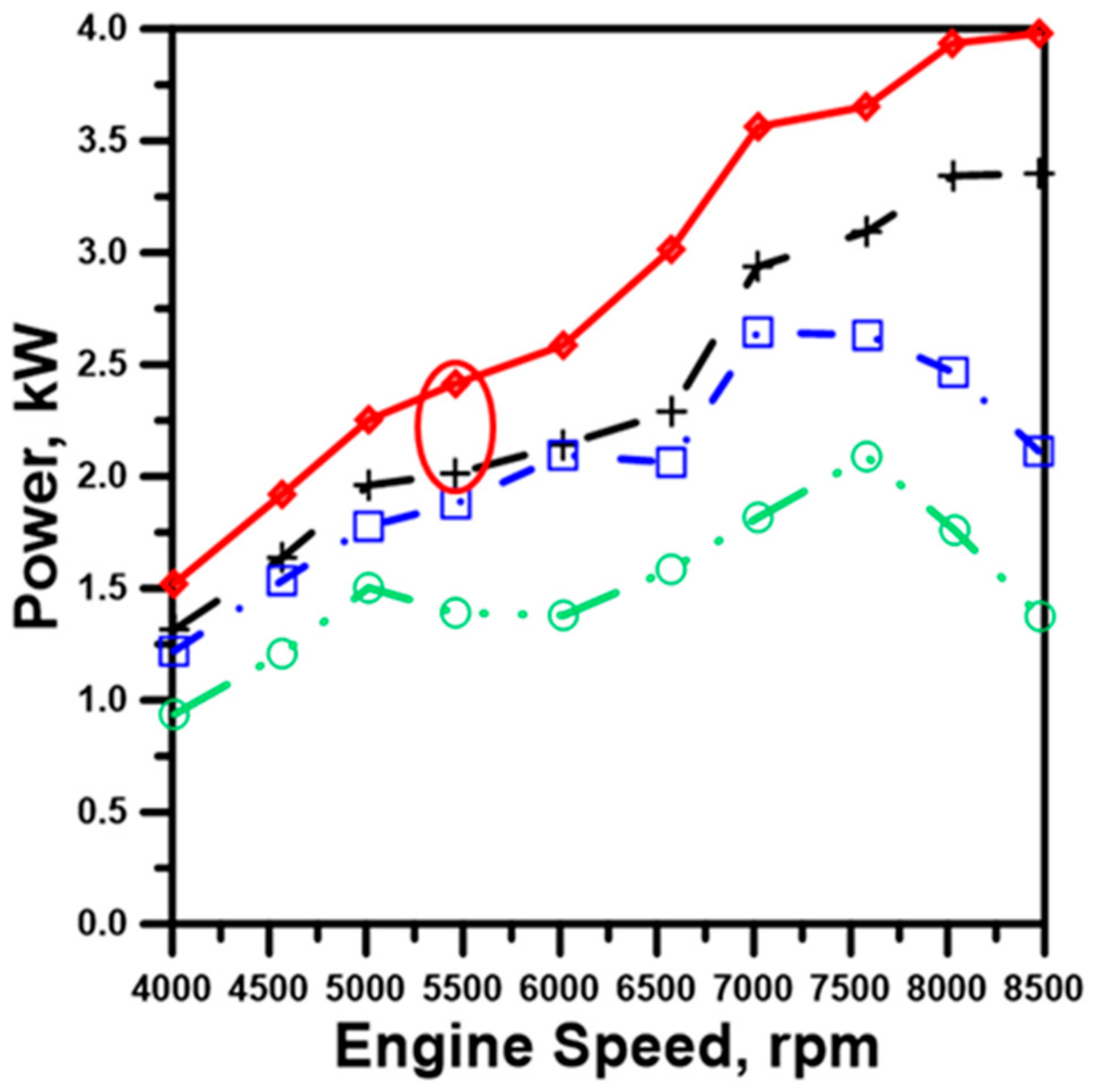

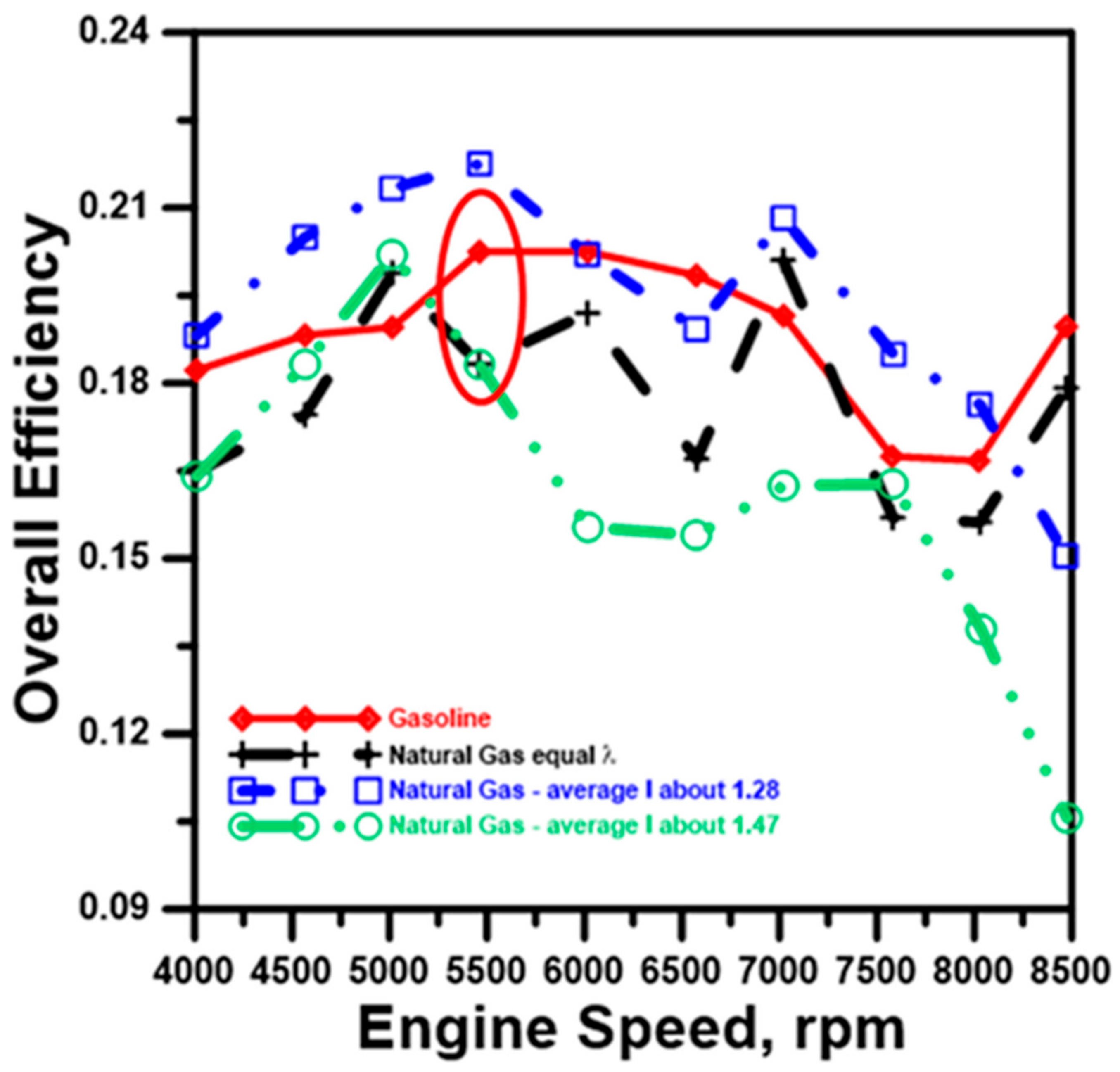

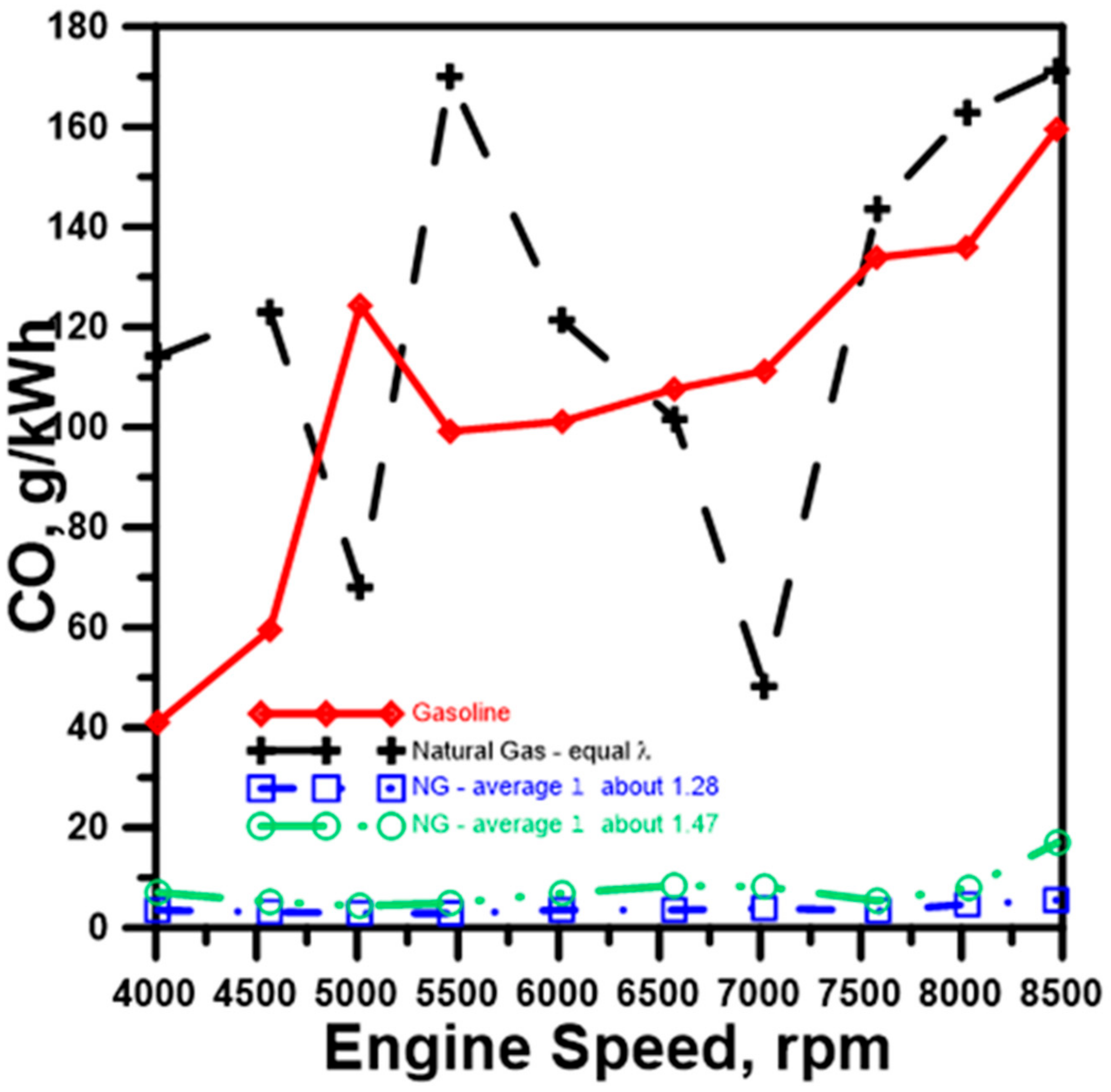
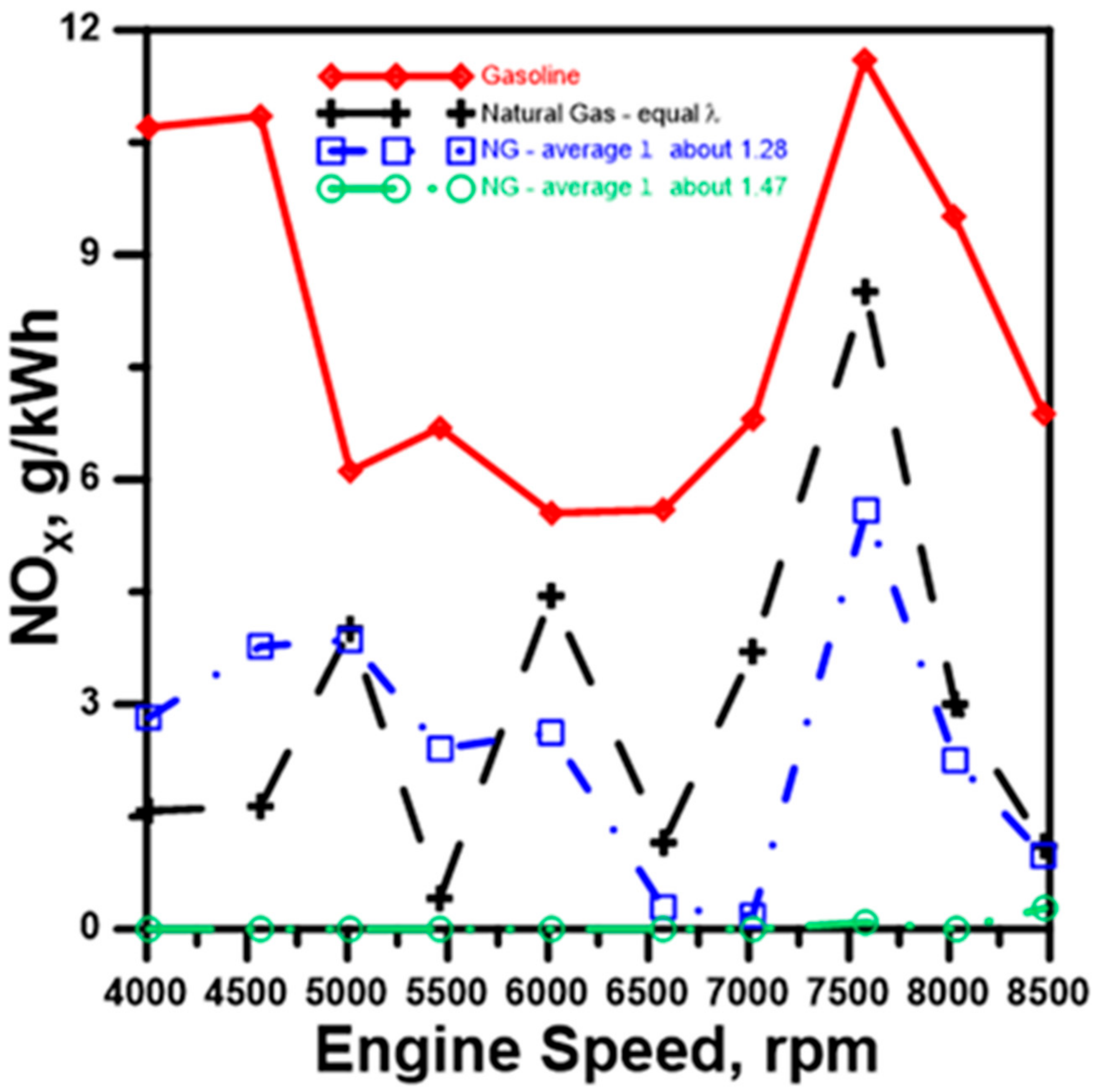
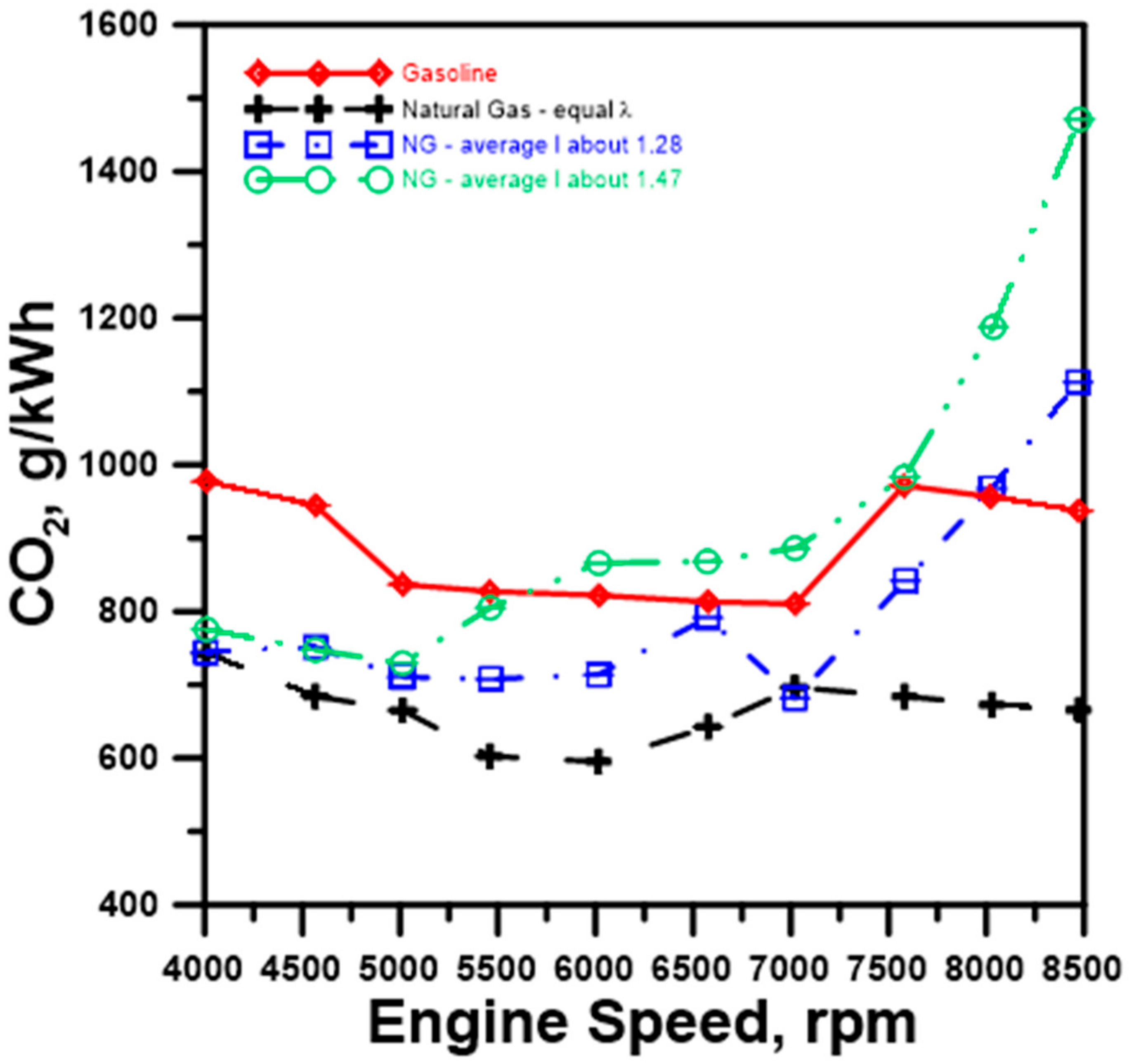





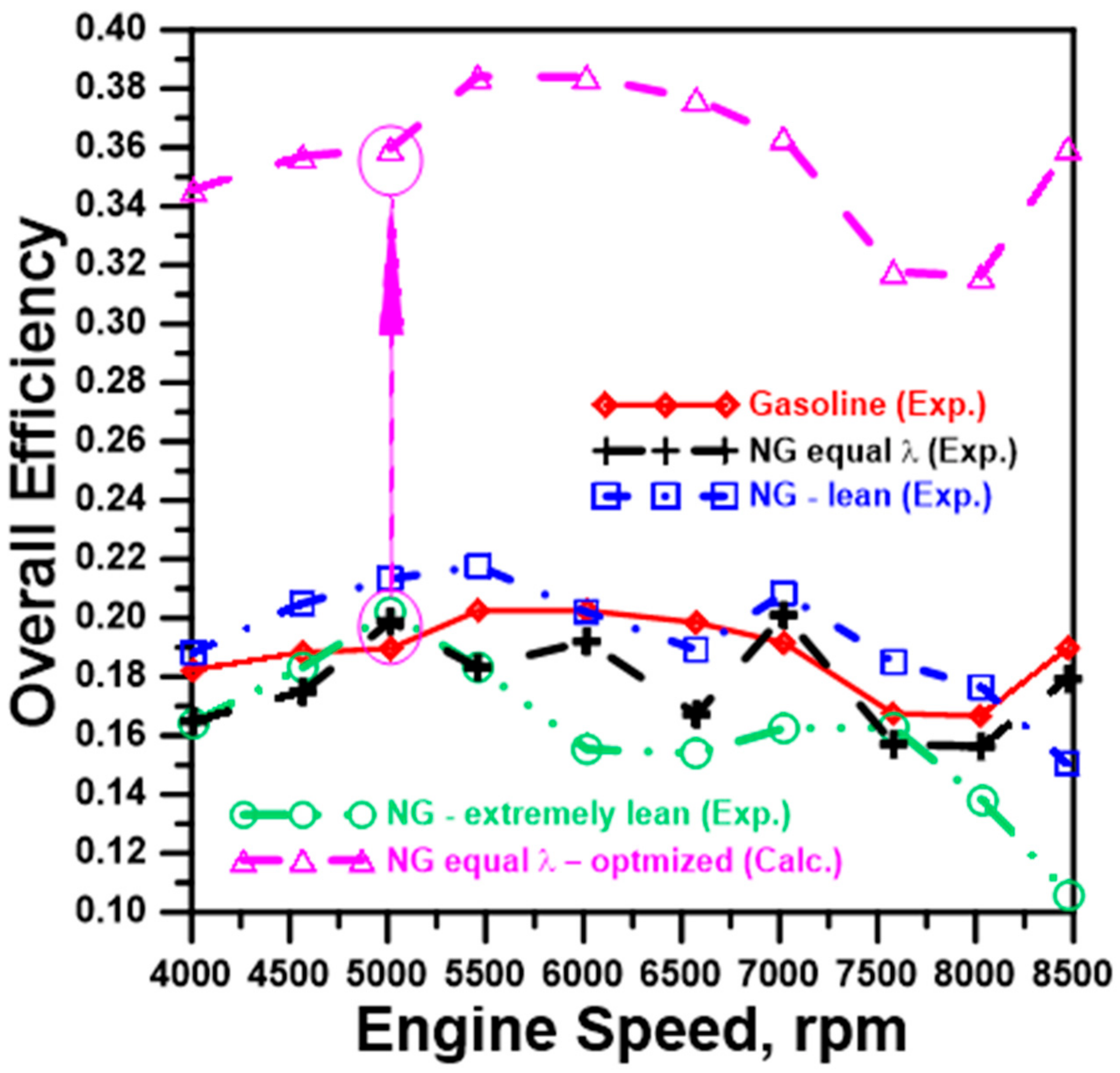
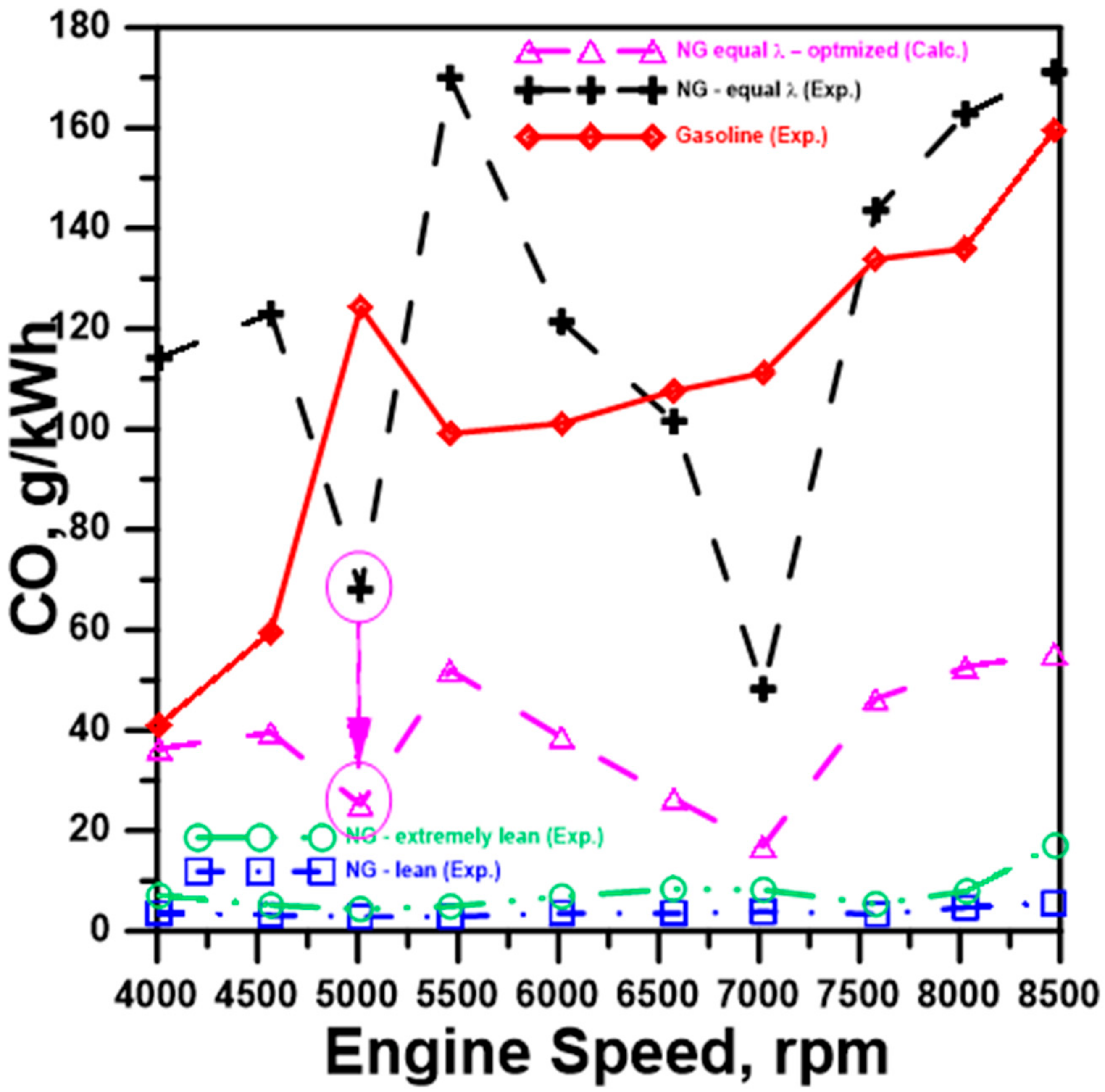
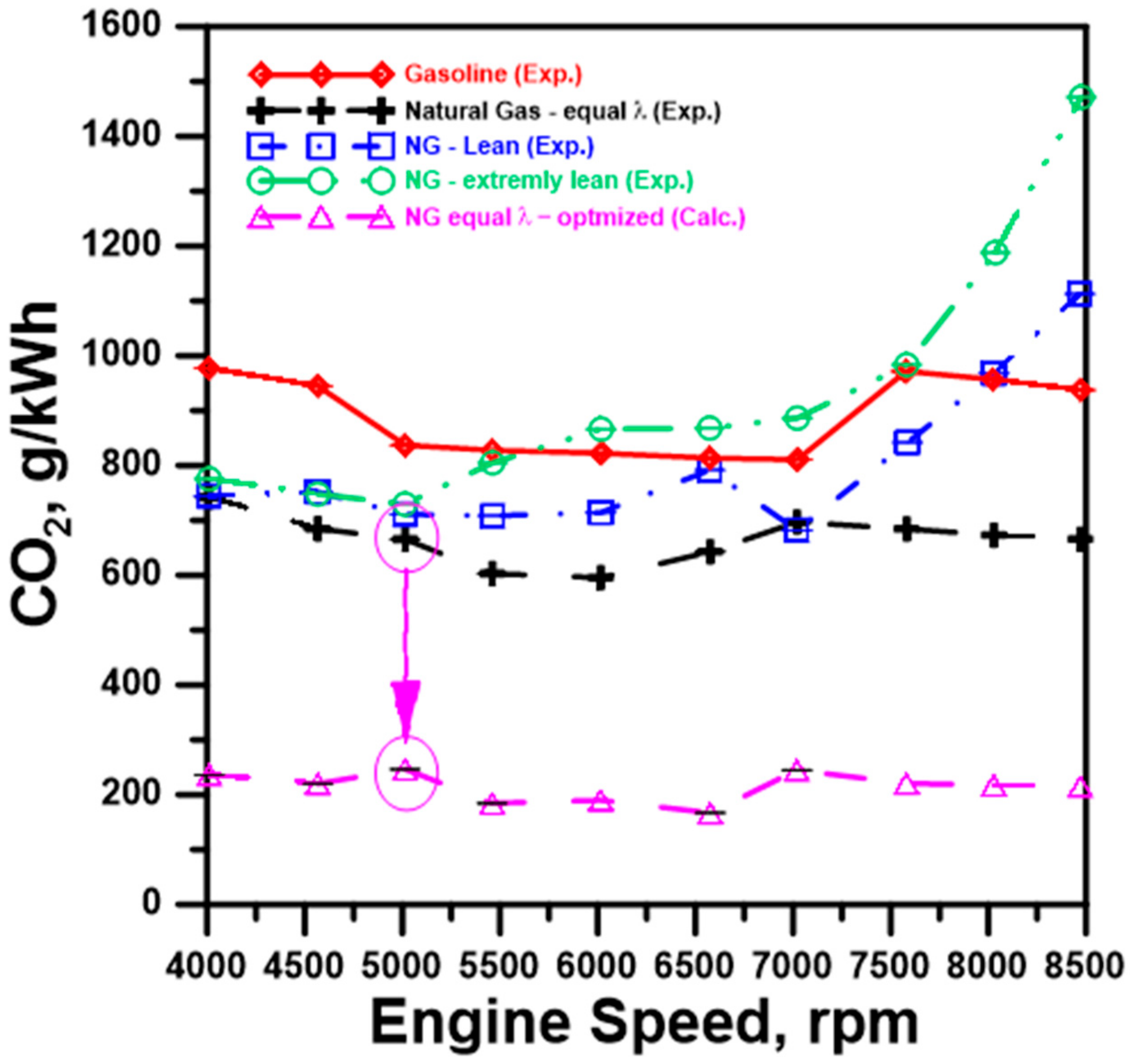
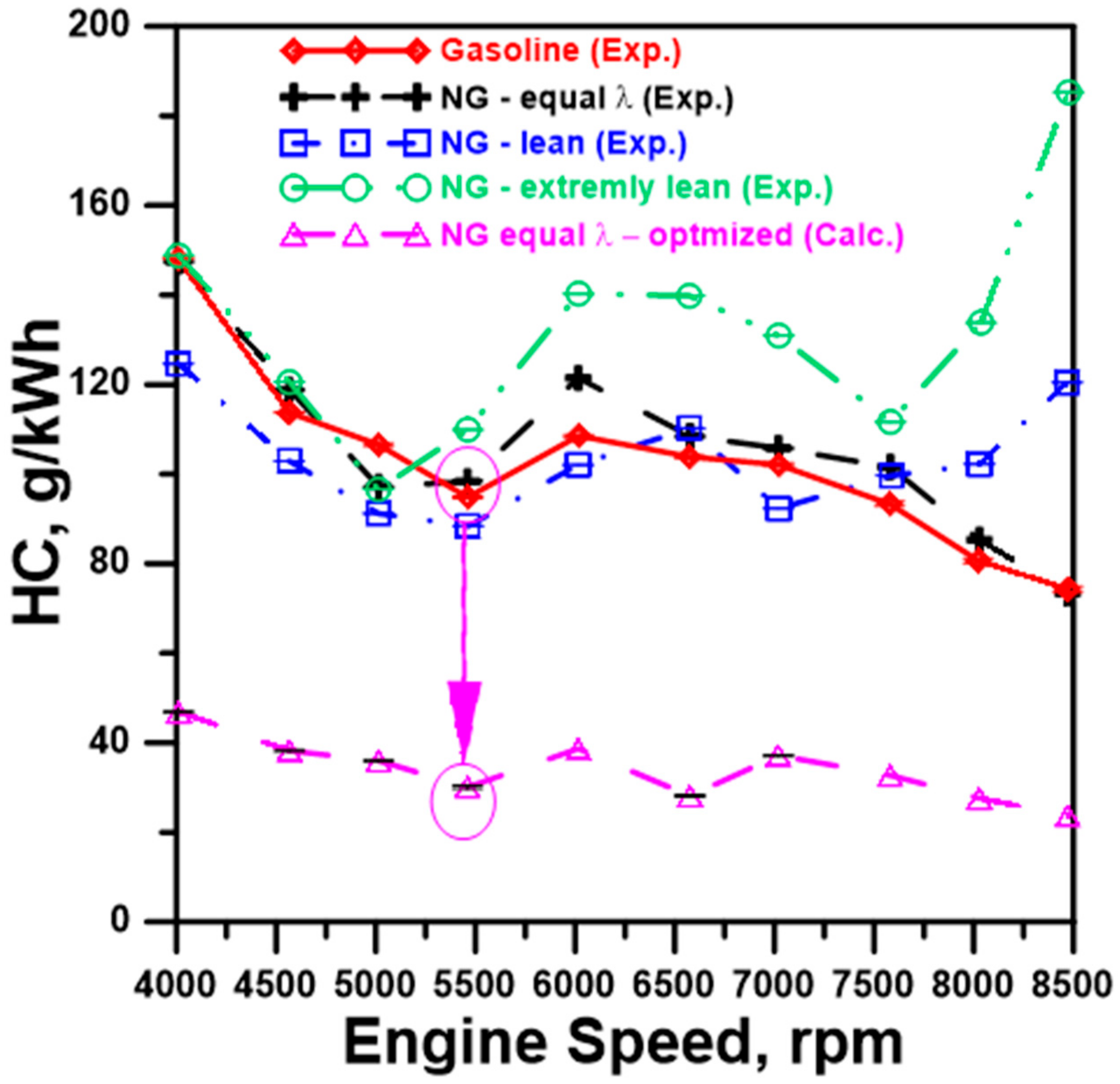
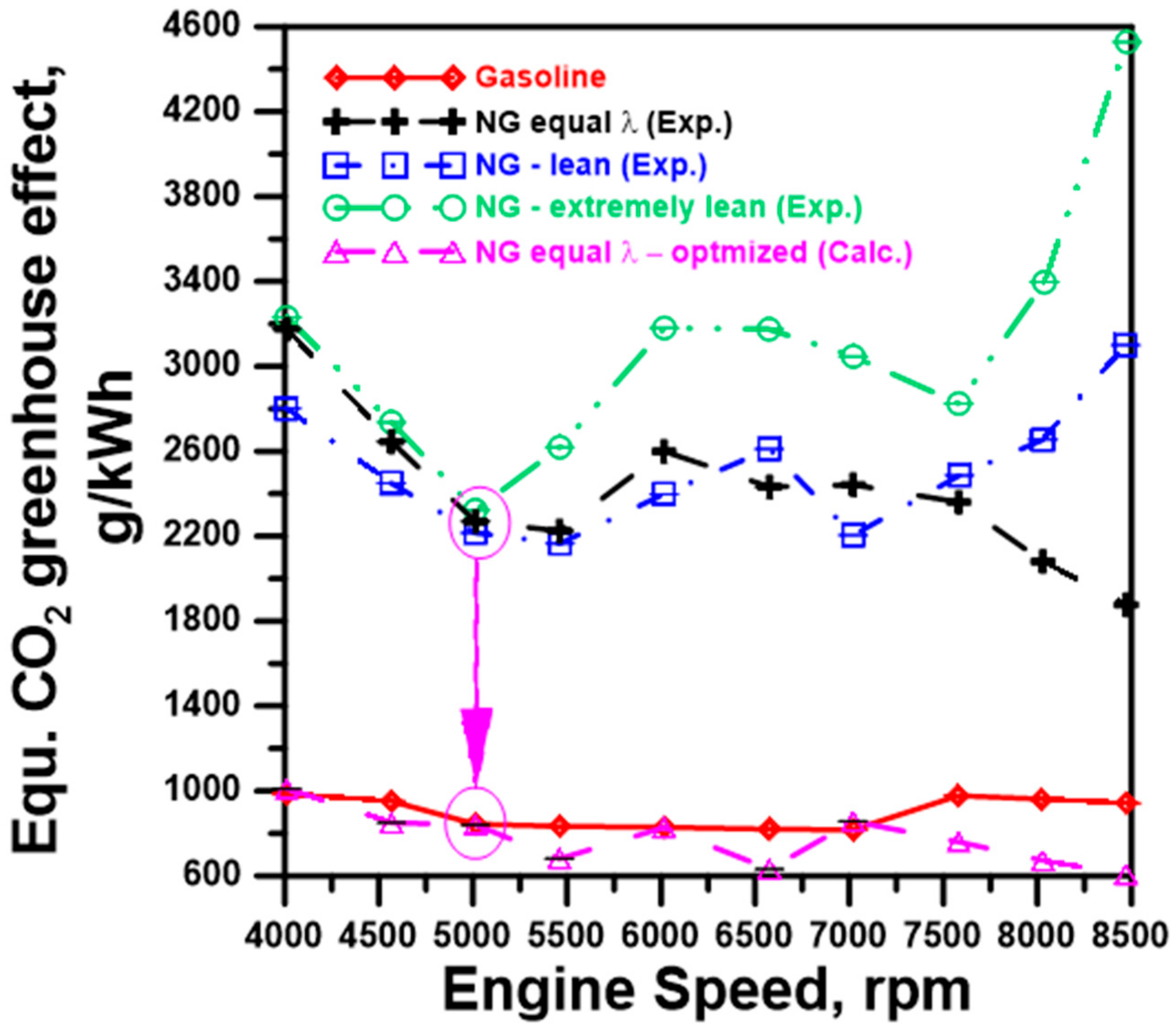
| 1 | DC electric motor/generator | 19 | PC + DAQ cards |
| 2 | DC motor control unit | 20 | Air mass flow meter |
| 3 | Morini 2-stroke engine | 21 | Angular position sensor |
| 4–12 | Thermocouples | 22 | NG tank |
| 13 | Strain gauge | 23 | NG pressure reducer |
| 14 | Encoder | 24 | NG mass flow meter/controller |
| 15–16 | Fast-response piezoresistive pressure transducers | 25 | Pressure gauge |
| 17 | Dynamic pressure transducer | 26 | Gasoline tank |
| 18 | Exhaust gas analyzer | 27 | Electronic scale |
| Engine Model | Ported Two-Stroke SI |
| Number of cylinders | 1 |
| Fuel | Gasoline |
| Scavenging Type | Schnurle |
| Displacement | 50 cm3 |
| Intake | With Reed-Valve assembly |
| Compression Ratio | 11.7 |
| Bore—Stroke | 41.0–37.4 mm |
| Brake Maximum Power | 4.11 kW at 8000 rpm |
| Brake Maximum Torque | 4.7 Nm at 7500 rpm |
| Maximum Rotational Speed | 10,000 rpm |
| Carburetor | Dell’Orto PHVA 12 |
| Intake Port Open/Number/Width | 56° BBDC/5/11 mm |
| Exhaust Port Open/Number/Width | 81° BBDC/1/26 mm |
| Weight | 19 kg |
| Chemical Species | Molecular Formula | Concentration [Vol%] |
|---|---|---|
| Methane | CH4 | 88.27 |
| Ethane | C2H6 | 4.37 |
| Propane | C3H8 | 1.71 |
| Butane | C4H10 | 0.50 |
| Pentane | C5H12 | 0.15 |
| Hexane | C6H14 | 0.01 |
| Oxygen | O2 | 0.10 |
| Nitrogen | N2 | 4.38 |
| Carbon dioxide | CO2 | 0.51 |
| Properties | Natural Gas |
|---|---|
| Mean Molecular Weight | ≈18.12 kg/kmol |
| Stoichiometric Air-Fuel Ratio | ≈15.56 |
| Lower Heating Value | ≈45.471 kJ/kg |
| Properties | Gasoline |
|---|---|
| Mean Molecular Weight | ≈110.00 kg/kmol |
| Stoichiometric Air-Fuel Ratio | ≈14.60 |
| Lower Heating Value | ≈43.700 kJ/kg |
| Gasoline | Natural Gas (Equal λ) | Natural Gas (Lean Mixture) | Natural Gas (Extremely Lean Mixture) | |
|---|---|---|---|---|
| 0.82–1.05 | 0.88–1.04 | 1.14–1.34 | 1.41–1.55 | |
| 0.92 | 0.95 | 1.28 | 1.47 |
| Engine Speed [rpm] | |||||
|---|---|---|---|---|---|
| 4000 | 0.87 | 0.97 | 1.02 | 0.97 | 0.91 |
| 4500 | 0.86 | 0.96 | 0.98 | 0.97 | 0.93 |
| 5000 | 0.87 | 0.95 | 0.90 | 0.97 | 1.05 |
 |  |  |  |  |  |
| 6000 | 0.83 | 0.95 | 1.00 | 0.97 | 0.90 |
| 6500 | 0.76 | 0.89 | 1.04 | 0.97 | 0.84 |
| 7000 | 0.83 | 0.95 | 0.85 | 0.97 | 1.05 |
| 7500 | 0.85 | 0.97 | 0.95 | 0.97 | 0.94 |
| 8000 | 0.85 | 0.97 | 0.93 | 0.97 | 0.94 |
| 8500 | 0.84 | 0.97 | 0.99 | 0.97 | 0.91 |
| Chemical Species | ppm C | Chemical Species | ppm C |
|---|---|---|---|
| Methane (CH4) | 29,000 | Methane (CH4) | 565 |
| Ethane (C2H6) | 2590 | Ethane (C2H6) | 250 |
| Ethylene (C2H4) | 89 | Ethylene (C2H4) | 1250 |
| Propane (C3H8) | 658 | Propane (C3H8) | 20 |
| Propylene (C3H6) | 25 | Propylene (C3H6) | 950 |
| Acetylene (C2H2) | 5 | Acetylene (C2H2) | 295 |
| Butane (C4H10) | 196 | Butane (C4H10) | 1065 |
| Benzene (C6H6) | 11 | Benzene (C6H6) | 2010 |
| HC molecular weight > C6H6 | 426 | HC molecular weight > C6H6 | 34,845 |
| Tot FID meas. | 33,000 | Tot FID meas. | 41,250 |
| (a) | (b) | ||
Publisher’s Note: MDPI stays neutral with regard to jurisdictional claims in published maps and institutional affiliations. |
© 2021 by the authors. Licensee MDPI, Basel, Switzerland. This article is an open access article distributed under the terms and conditions of the Creative Commons Attribution (CC BY) license (https://creativecommons.org/licenses/by/4.0/).
Share and Cite
Gimelli, A.; Muccillo, M. Development of a 1 kW Micro-Polygeneration System Fueled by Natural Gas for Single-Family Users. Energies 2021, 14, 8372. https://doi.org/10.3390/en14248372
Gimelli A, Muccillo M. Development of a 1 kW Micro-Polygeneration System Fueled by Natural Gas for Single-Family Users. Energies. 2021; 14(24):8372. https://doi.org/10.3390/en14248372
Chicago/Turabian StyleGimelli, Alfredo, and Massimiliano Muccillo. 2021. "Development of a 1 kW Micro-Polygeneration System Fueled by Natural Gas for Single-Family Users" Energies 14, no. 24: 8372. https://doi.org/10.3390/en14248372






